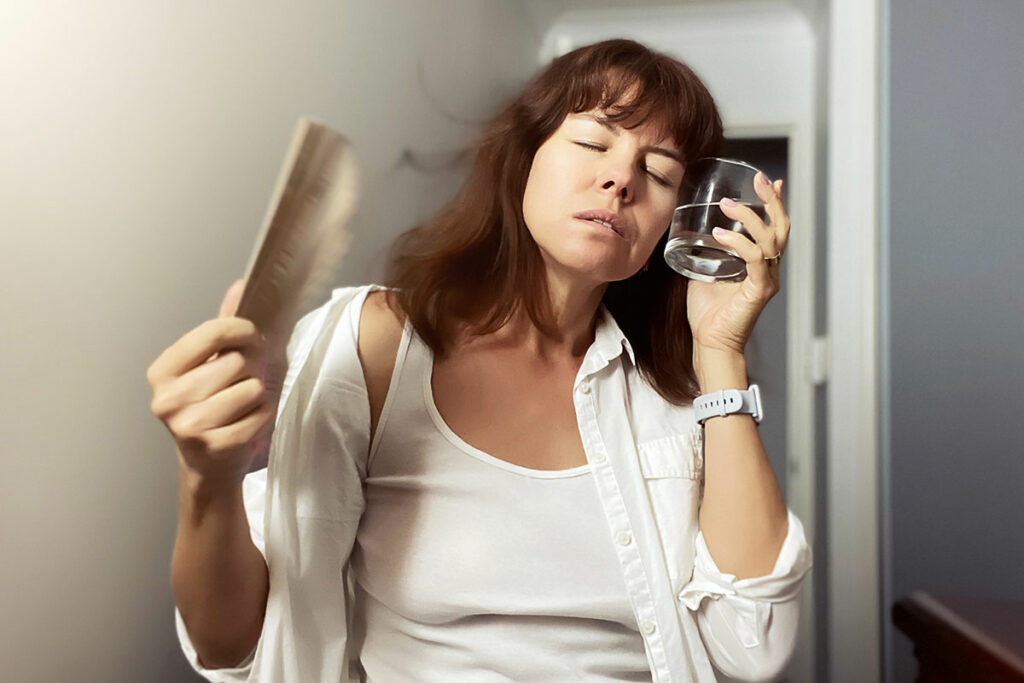Most women dread the word menopause. In reality it affects women in completely different ways, but the most common symptoms include hot flushes, sweating, insomnia, anxiety, impairment of memory and fatigue. Long term consequences can include a decline in libido,vaginal dryness or pain, osteoporosis, heart disease, even dementia- all linked to reduced oestrogen levels.
Here are a few natural tips to help with menopause.
Firstly, avoiding certain types of foods can make menopause more bearable. Stop eating foods that are likely to trigger or worsen hot flushes and night sweats. Avoid stimulants such as coffee, alcohol and chocolate and spicy foods, especially at night – they’re notorious for setting off hot flushes.
Avoid snacking on sugary foods – all too often a sharp rise in your blood glucose level may be followed by a sharp dip which leaves you feeling tired and drained. Choose fresh fruit with a few nuts instead.
Many people associate menopause with weight gain, but as we get older, we need fewer calories. Eating a bit less sounds a simplistic solution but it will help. Watch the amount of fat in your diet and cut back on sugar.
For dry skin, legumes, nuts and seeds such as pumpkin, sunflower, almonds contain Vitamin E, zinc and calcium. These nutrients and the oils in nuts and seeds may help prevent dry skin and normalize hormone levels. Don’t forget the wonderful properties of avocadoes to help with good fats. Also, try massaging your skin with organic coconut oil, which has anti-fungal properties which will also help with dryness.
To help with depression ensure you eat enough protein foods which contain the amino acid tryptophan. You can find it in turkey, cottage cheese, oats and legumes. Tryptophan helps manufacture the neurotransmitter serotonin. Serotonin helps moods and may help control sleep and appetite which can make you feel better in yourself.
Bone health is another aspect of menopause to be watchful of, women going through menopause should increase their intake of food sources of calcium, magnesium and vitamins D and K to maintain integrity of the skeleton. In addition, high amounts of phosphorous – found in red meat, processed foods and fizzy drinks SHOULD ALSO BE AVOIDED. Too much phosphorous in the diet accelerates the loss of minerals such as calcium and magnesium from bone. Reducing sodium, caffeine and protein from animal products cal also help the body maintain calcium stores.
Eat foods high in magnesium and boron. These are minerals which are important for the replacement of bone and this help to reduce the risk of osteoporosis. Apples, pears, grapes, dates, raisins, legumes and nuts are good sources of boron.
HERBS – my two favourite herbs for treating menopausal women are shatavari and zizyphus. Shatavari has a long tradition in Ayurvedic medicine. It’s an excellent tonic for improving libido and energy, and a great stress adaptogen. Zizyphus helps with anxiety in perimenopausal and post-menopausal women. Other herbs I use include rehmannia, as it decreases heat in the body; sage, which reduces hot flushes and promotes sleep and wild yam – this is not progesterone as such, but it may provide the body with the steroidal precursor.
FOOD – Phytoestrogen are weak plant oestrogens that prevent oestrone levels from increasing by occupying their space. Flaxseed has been extensively researched for its oestrogenic effects, which some research showing it works just as well as traditional osetrogen therapy for women suffering from the side effects of menopause. I prefer the seeds as they contain fibre and some omega-3 in addition to phytoestrogens; 25 grams a day is all you need. The key is to be constant with it.
Soy is another option, but is should be fermented to avoid setting up gastrointestinal problems or allergies. Indole-3-carbinol, present in cruciferous vegetables, balances oestrogen by stopping the oestrone from docking at is site. Glucaric acid helps with glucuronidation, which is part of a detoxification process that helps remove oestradiol from the body. A craving for peanuts may be a signal that your body needs it, as peanuts are an excellent source. Other sources include watermelon, pumpkins, squash, lettuce, red and green capsicums, apples, grapefruit, broccoli, strawberries, raspberries, apricots, cherries and legumes. Omega-3 is important for post-menopausal women to decrease inflammation for several reasons, notably heart health: by reducing arterial inflammation, plague and cholesterol build-up in lessened.
Vaginal changes – I’m often asked about ways to deal with changes in vaginal tissue. The best thing I can advise women to do is to take probiotics, which help florinate vaginal tissue, and maintain the acid balance. However, it will take two or three months. Alternatively, use a little suppository of yogurt, and before sex apply some sweet almond oil.
MACA AND MENOPAUSE – A nutritional remedy you may like to consider for hormone imbalance at menopause is maca. It comes from high in the Andes Mountains where it is still farmed by hand, free from chemicals and pesticides. When grown at an altitude where the air is unpolluted and the ground and water are rich in minerals, maca has an amazing richness of proteins, vitamins, minerals and amino acids.
The use of mace has an ancient history. It was known by the Incas to be a potent source of energy and healing, and its benefits as an aid to fertility were revealed to the Spanish conquerors who made records of its spectacular results. Today in Peru and round the world, health professionals dispense maca as a safe and natural alternative to drugs. Dr. Gloria Chacona Peruvian biologist and leading researcher into the benefits of maca, believes it has a place as an alternative to hormone replacement therapy (HRT).
Dr Chacon has isolated four alkaloids specific to the mace variety. Lepidum peruvianum Chacon, that encourage fertility and hormonal balance in both men and women. This medicinal variety of mace root works in a fundamentally different way to many of the products being offered to treat hormonal imbalance. According to Dr. Chacon, Ït is important to remember that maca does not itself contain any hormones, but its action on the body stimulates the pituitary into producing precursor hormones which ultimately end up raising oestrogen, progesterone and testosterone levels as well as aassisting in the balancing of the adrenal glands, the thyroid and the pancreas”.
It has been shown that women who start using mace in the peri-menopausal phase have fewer symptoms in their menopause. After menopause, maca helps keep the skin young and prevents vaginal dryness and atrophy. Its high mineral content also helps fight osteoporosis by strengthening the bond structure. As an added benefit, the action of the Certified Chacon variety of mace leads to a natural energy boost for those who are stressed or suffering from chronic fatigue.


